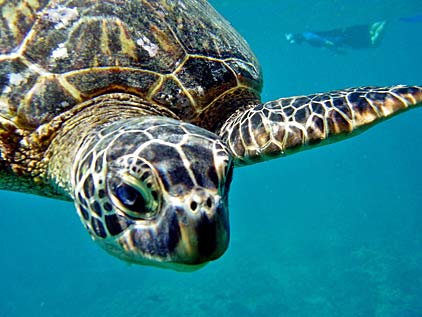|

|
Nature dominates
Teachers find fearsome yet
fascinating specimens of sea life
ABOARD THE HI'IALAKAI » Each day that the ship Hi'ialakai presses on northwesterly, the 10 Hawaii teachers on board are thrust deeper into this world of endless sea and sky.
|
|
"In the main Hawaiian Islands, people are dominant and when you go in the water, everything else is afraid of you," Golden said. "Now we're in an environment where nature dominates and that's how it should be."
Other than the few humans on this National Oceanic and Atmospheric Administration vessel, every living thing in this vast water wilderness spends the majority of its time in the ocean or in the air.
This is where the Hawaiian islands turn into scraps of land.
But it's more than enough for the air-breathing animals -- the birds, the Hawaiian monk seals and the green sea turtles -- that must come to hatch or give birth to their young.
"I saw some fish I'd never seen before, and I snorkel all the time," said Sandy Webb, a Mililani High School biology teacher, after three days of snorkeling.
"And when I recognize them, every fish I see here is two times as big as at home. These are some healthy, strapping specimens. Before now, I've only seen papio (juvenile ulua), not ulua."
On the second snorkel trip at Nihoa, "There was a whole school of reef fish feeding and they weren't worried about us," said Cobey Doi, fourth-grade teacher at the Big Island's Hawaii Preparatory Academy. "I have never seen so many fish at one time."
Alan Nakagawa, director of Mobile Education Partners on the Big Island, brought a fisherman's perspective to the feast of fish. "I got hungry down there. I do a lot of diving and spear fishing on the Big Island and you've gotta travel a long way to find fish you want to put on your table," he said.
"Here, they were around every corner," Nakagawa said. "On the main islands it's not very easy to approach them, but here you could get within five feet, which is pretty unheard of."
Dan Suthers, a University of Hawaii associate professor who specializes in the use of computers for educators, told of a green sea turtle swimming closer and closer to him while he held still, taking photos.
"When it got about six inches from the camera lens, I found myself saying to it, 'What are you doing?'" he said.
On Monday at the reef off East Island in French Frigate Shoals, the afternoon snorkeling crew saw two manta rays (hahalua) with "wing" spans of 8 feet "fly" through the ocean.
Their movement is graceful but languid, and despite the lack or teeth and stingers, they still look intimidating.
And then there are the birds, so many of them that a tang of ammonia from their droppings hangs in the air.
The hard-weathered cliffs of Mokumanamana seem impossible for humans to climb, but at one point they were home to some; they left behind 33 stone structures that line the rocky island's ridge top.
Sabra Kauka, Hawaiian studies teacher and cultural resource person for schools on Kauai, is keeping an eye out for food that Hawaiians of the past could have lived on.
"There are plenty of fish, but you need more than that," Kauka said. "I'm looking for limu that we eat in the main islands. I'm wondering, did they bring sweet potato and poi?"
For Kauka, a native Hawaiian who has spent years studying her ancestors' ways, every day of this journey is a revelation.
"When we were in the crystal-clear waters at Mokumanamana, there was a 65-foot drop. With the quality of light, it's like being in a natural cathedral. The clarity, the visibility -- it's clean water, clean ocean."
E-mail to City Desk
[News] [Business] [Features] [Sports] [Editorial] [Do It Electric!]
[Classified Ads] [Search] [Subscribe] [Info] [Letter to Editor]
[Feedback]
